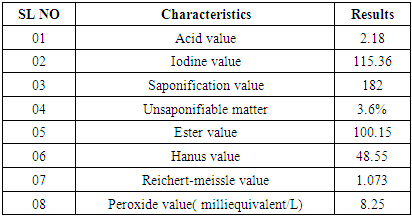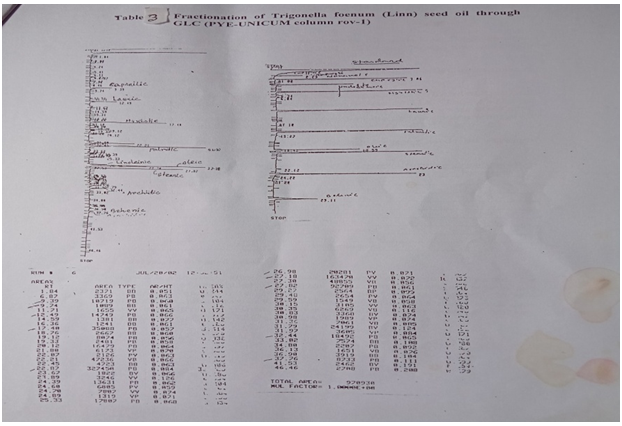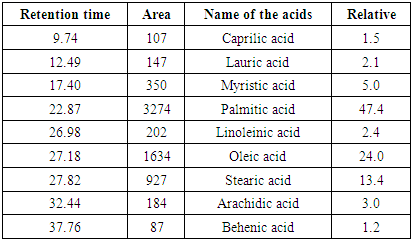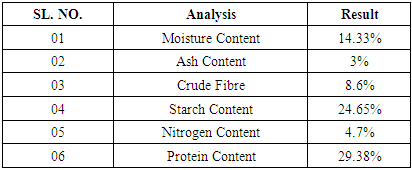-
Paper Information
- Paper Submission
-
Journal Information
- About This Journal
- Editorial Board
- Current Issue
- Archive
- Author Guidelines
- Contact Us
American Journal of Organic Chemistry
p-ISSN: 2163-1271 e-ISSN: 2163-1301
2023; 11(1): 1-4
doi:10.5923/j.ajoc.20231101.01
Received: Mar. 11, 2023; Accepted: Apr. 17, 2023; Published: Apr. 23, 2023

Studies on Seed Oil Characteristics of Trygonella Foenum (Methi Seeds)
Kazal Baran Nath1, Dr. Sreebash Chandra Bhattacharee2
1Assistant Professor, Institute of Education & Research (IER), University of Chittagong, Bangladesh
2Principal Scientific Officer, BCSIR Laboratories Chattogram
Correspondence to: Kazal Baran Nath, Assistant Professor, Institute of Education & Research (IER), University of Chittagong, Bangladesh.
| Email: |  |
Copyright © 2023 The Author(s). Published by Scientific & Academic Publishing.
This work is licensed under the Creative Commons Attribution International License (CC BY).
http://creativecommons.org/licenses/by/4.0/

Oil Characteristics of the seeds of Trigonella foenum graecum Linn were studied. After purification physical chemical characteristics of the oil were determined and these values were compared with those of the standard oils. Fatty acid compounds of the oil were estimated by GLC. The ash, protein, phosphorus, moisture, crude fibre, starch, nitrogen, manganese contents of the cake were also determined.
Keywords: GLC, TLC, Customary constant
Cite this paper: Kazal Baran Nath, Dr. Sreebash Chandra Bhattacharee, Studies on Seed Oil Characteristics of Trygonella Foenum (Methi Seeds), American Journal of Organic Chemistry, Vol. 11 No. 1, 2023, pp. 1-4. doi: 10.5923/j.ajoc.20231101.01.
1. Introduction
- Trigonella foenum graecum Lin. fenugreek is one of the 70 species of the genus Trigonella belonging to the family papilonacea. It is an annual herb, a native of the mediterranean region, Europe, Asia, South Africa and Australia. It is also found to grow in the sub tropical region of India and Bangladesh. It is called as methi, methishak, methuka in our country. An annual herb 1-2 feet high, with an erect, slightly branched, cylindrical hallow smooth or slightly pubescent stem, root tapering. Leaves alternate on rather long stalks, trifoliolate, stipules 1/4 inch long. flowers sessile, solitary in the axils of the leaves calyx long and narrow. The seeds are used as a condiment and for flavouring food preaparation. they may be eaten raw or cooked in Egypt, ground seeds are mixed with wheat flour for making bread. The plant possesses insect-repellent properties. In Punjab Agriculturists mix the dried plants with stored grains to protect them from ravages of insects especially the rainy season. Present work mainly deals to carry out complete study of the physical and chemical characteristics of the oil to get information for industrial applications of the fatty oil.
2. Material and Methods
- The seeds of Trigonella foenum graecum Linn. were collected from hervesting field from north district of Bangladesh. For seed and fodder, deshi methi is from mid September to November. The seed rate for deshi methi is 30-35kg/hector and for kasuri-methi is 23-27 kg/hector. 1. Extraction of the oil from seeds and its purification.Extraction; at first methi seed was crushed and then crushed seed was taken in a thimble prepared of filter paper. Definite amount of crushed seed (97g) was taken in the thimble and the thimble was placed in the soxhlet extraction unit. Petroleum ether (60-80°C) was used as solvent for extraction. Hot extraction was carried out in water bath for 24 hours at (80-90°C).Purification: The methi fatty oil in the solvent obtained from soxhlet unit was filtered to remove impure materials. The solvent was removed from the mixture by using a condenser operating at 90°C. At this temperature pet ether vaporize and when this vaporized petether passes through condenser and this condensed petether was collected in a RB flask. The petroleum ether solvent was pumped out from the mixture by using a water pump. The trace amount of solvent remained in the fatty oil was eliminated by using high vaccum. Finally the oil is as dried over anhydrous sodium sulphate. By this process 4.88ml fatty oil was found. The percentage of the fatty oil 5% was calculated.Physical parameter characteristics studies of the oilAll the physical characteristics of Trigonella foenum graecum such as color, appearance, specific gravity, refractive index were determined by conventional methods under reference and the result are shown in Table-1.
|
|
|
|
|
3. Results and Discussion
- The physio-chemical characteristics of Trigonella foenum oil was estimated. Its oil content was to be 5% which is higher percentage quantity than super critical CO2 extraction (SC-CO2) of method carried by Renming et al. They got the percentage of oil was 3.78%. Table-1 report the analysis of physio-chemical characteristics of the oil. From the data, it has been seen that the refractive index of the oil was 1.4815 at 29 c which indicate that the oil contains long chain fatty acids. The specific gravity of the oil was determined and found to be 0.9167 at 30°C. The viscosity of the oil was found to be 0.2725 at 30°C which indicates that the oil contain low molecular weight of fatty acids. The acid value and the percentage of FFA (as oileic) was calculated and it was found to be 2.18 and 1.10% respectively which indicates that the oil is not suitable for edible purpose. Another researcher (Ling –Biao et. al.) found the refractive index was 1.479+_0.233, relative density 0.922+0.021 which are nearable same the getting value. We found The safonification value, iodine value and Peroxide value were found to be 182 and 115.36 g oil and 8.25 mili equivalent 02 per Kg of oil but another researcher (Khaled Hamden et. al) found that 189, 110 and 12 mili equivalent O2 per Kg respectively, which were very close to the result. The safonification value indicates the presence of high proportion of higher fatty acid and iodine value also indicates the oil to be unsaturated one which was very samely revealed with GLC result. Again the peroxide value indicates that the oil is unsaturated and it is confirmly indicate by the oil characterization. The fatty acid composition was determined by GLC. It was found that (as shown in Table-4) the oil contained the highest proportion of palmitic acid 47.4%. Other fatty acid e. g. oleic acid 24%, stearic acid 13.4%, myristic acid 5% and arachidic acid 3% were also found in significant amounts. The acid constituent also revealed the result of SC-CO2 method which composed of 28.3% c 18:3, 33.45% C 18:2, 9.89% C 16, 8.1% C18:1, 3.7% C18, 0.71% C20 and 0.61% C22 (Renming et al.) The fenngreek oil is rich in unsaturated fatty acids and polyunsaturated fatty acids accounted for 61.42% of the total amount. Some standard fatty acid methyl ester samples were used in the GLC analysis. There are still unknown peaks which could not be identified for want of reference samples. It is evident from the Table-4 that the seed oil contains considerable amount palmitic acid and this may be trapped as a source of palmitic acid. From Table-5 the qualitative and quantitative composition of the de-oiled portion of oil cake showed about 29.38% protein and 24.65% starch content followed by about 8.6% crude fibre. Another researcher (Ahamad Dilbhad, J. for medicinal chemistry) showed the content of moisture (5.47+0.66)% and oil content (7.04+021)% whereas we found in 14.33% moisture in the form of oil cake. We get protein in oil seed cake 29.38% but other researcher (Nasim Khorbhidian et al., Nutrition and food science research) found 25.4% and get excellent percentage of minerals 3%.
 Abstract
Abstract Reference
Reference Full-Text PDF
Full-Text PDF Full-text HTML
Full-text HTML



